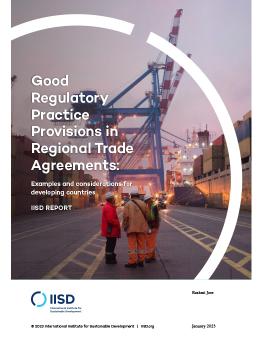
Good Regulatory Practice Provisions in Regional Trade Agreements
Examples and considerations for developing countries
Governments are increasingly negotiating rules on non-tariff barriers in their trade agreements, looking to address this significant source of trade costs. This paper looks at the U.S.-Mexico-Canada Agreement and the EU-Canada Comprehensive Economic and Trade Agreement to see how their respective approaches to good regulatory practices (GRPs)—a type of regulatory policy provision—and what developing countries and least developed countries should consider in their own trade negotiations.
As non-tariff barriers become an increasingly relevant source of trade costs, regulatory policy has become an important feature in trade negotiations and the trade policy agenda overall. This paper provides an overview of how stand-alone regulatory policy chapters are increasingly featured in recent regional trade agreements (RTAs). It then does an in-depth analysis of a specific type of regulatory policy provision—that of good regulatory practices (GRPs)—as these types of provisions are becoming more prolific and are being integrated into a more diverse range of agreements involving both developed and developing countries.
The paper analyzes how GRPs, especially those promoting stakeholder engagement, are evolving in select key RTAs, notably that of the United States–Mexico–Canada Agreement (USMCA) and the EU-Canada Comprehensive and Economic Trade Agreement (CETA). The paper concludes with key insights highlighting the policy implications for developing and least developed countries and proposes some considerations for policy thinking.
This material has been produced with funding from UK aid from the UK Government. Views expressed in the publication are the author’s own and do not necessarily reflect HM Government’s official positions.
Participating experts
You might also be interested in
IISD Trade and Sustainability Review, October 2024
This edition of the IISD Trade and Sustainability Review presents five unique perspectives on the global governance landscape of digital trade.
Adding Fuel to the Fire: How export restrictions can exacerbate climate change’s impacts on global food security
Higher temperatures will likely reduce agricultural yields and production in most countries, raising global food prices and worsening food security. Avoiding export restrictions is crucial.
Global Cooperation on Border Carbon Measures: Broaching the tough issues
The need for international cooperation on border carbon adjustment (BCA) is becoming increasingly urgent. What are the most difficult issues to overcome and what steps can we take toward resolving them?
IISD Annual Report 2023–2024
While IISD's reputation as a convenor, a trusted thought leader, and a go-to source on key issues within the sustainable development field is stronger than ever, the work happening outside the spotlight is just as valuable.